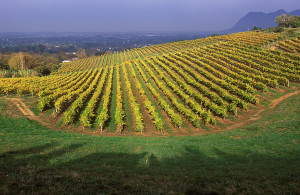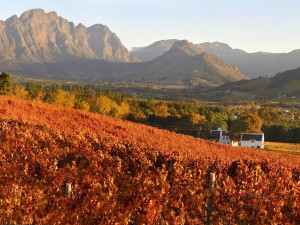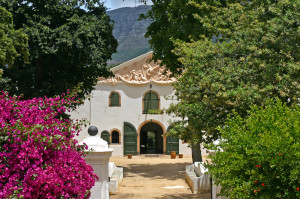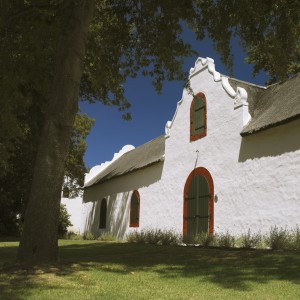Today we have a conference preview from Jim Clarke, Marketing Manager with Wines of South Africa (WOSA). In this post, Jim tells us about his upcoming session on the history of South African wine production, entitled “South Africa: Wine from before America’s Birth.” Jim’s session is offered as part SWE’s 43rd Annual Conference, to be held August 14 – 16 in Washington DC.
One reductive—but nonetheless useful—cliché about South African wine is that it is “a little bit Old World, a little bit New.” This reflects two realities. One is that in character, as much as one can still speak of Old World and New World traits in wine, South Africa’s wines often fall somewhere in between. A typical South African Sauvignon Blanc, for example, would not be likely to mistaken for a Marlborough sample of the same variety, nor would one think it was a Sancerre; instead, its character would have aspects of both. The other reality reflected in this commonplace is South Africa’s lengthy history with growing winegrapes. The nation celebrated its 360th vintage this year.
In fact, by the time our own country was struggling for its independence, South African wines were being celebrated in the courts of Europe, or at least one of them—Constantia—was. It owes its existence to Simon van der Stel, the son of a Dutch East India Company official and an Indian woman whose mother had been a slave. Van der Stel would follow in his father’s footsteps as a Company administrator. In 1679 the Company made him the tenth commander of the Cape Colony, and later promoted him to the newly created position of governor.
In 1685 the Commissioner of the Company, Hendrik Adriaan Van Rheede, visited the Cape. Impressed by Van der Stel’s work, he granted the Commander title to a piece of land; typically this was forbidden, to prevent conflicts between the Commander’s own interests and those of the Company. Van der Stel named the 763 hectare estate Constantia, apparently after the Commissioner’s daughter; a savvy “thank you” for a large and well-situated piece of property.
Van der Stel planted approximately 100,000 vines on the property. His interest in wine was not new; he had owned two vineyards in Holland, and he apparently brought cuttings with him from Europe when he took his post. Upon his arrival, he had been unimpressed with the wines he found at the Cape. While the Colony had been making wine for twenty years and vineyard plantings had expanded, there were few people with any real winemaking experience. Van der Stel cited unripe grapes and unsanitary barrels as the main offenders to wine quality in the Cape, and imposed fines on those who harvested too early or used inadequate vessels. He applied these sensibilities to his own property, and his wines were well-regarded. In 1699 he retired to live at Constantia full-time, and passed away there in 1712.

Groot Constantia vineyards looking over Cape Town—Photo Credit: Groot Constantia/WOSA/Graeme Robinson
The Constantia estate was sold at auction upon his death, and broken into three parts. A gentleman named Johannes Colijn eventually took ownership of Klein Constantia (a different portion of the original than today’s Klein Constantia, actually) and established an export market. By the 1730s he was finding it difficult to meet demand; fortunately, the larger Groot Constantia property was available for purchase, and he arranged for his brother-in-law to do so. For the next several decades the properties would operate more-or-less as one. By the 1740s Constantia’s sweet wines, made from red and white Muscat, were valuable enough for counterfeits were becoming a problem.
Constantia survives today as a region, but several estates include portion of the original property: Groot Constantia, Klein Constantia, Buitenverwachting, and Constantia Uitsig. Other vineyards around the base of Table Mountain, closer to Table Bay, have not survived. For the most part they have been swallowed up by Cape Town’s suburbs, one of which, Wynberg, or “Wine Mountain” at least acknowledges that history. The Company Gardens, where grapes were first planted in 1655, are a public park. A girl’s school and the University of Cape Town occupy the grounds where Rustenberg, as the second Company farm was called, and Bosheuvel, made wine. But many properties further inland have survived.
Estates further from the city in Stellenbosch and Franschhoek still thrive. One of the oldest estates actually shares the Rustenberg name. On the slopes of Simonsberg Mountain in Stellenbosch (both maned for Simon Van Der Stel), the property has been home to vineyards since 1682. On the far side of the Simonsberg, Jean Le Long, a French Huguenot, founded Boschendal in 1685, and began growing grapes there six years later. Le Long predates the arrival of 200 French Huguenots that began in 1688 – refugees fleeing persecution after Louis the XVI revoked the Edict of Nantes.
These Huguenots provided an influx of winemaking talent. The extent of their influence may be exaggerated—not all were from the wine-growing regions of France—but at least a few seem to have succeeded and even surpassed their Dutch-descent neighbors in winegrowing. Bellingham (originally “Bellinchamp” or “pretty fields”), La Motte, and several other farms are rooted in this immigration. The Dutch had their own successes at the end of the 17th century; Vergelegen and Rust En Vrede owe their starts to Simon Van Der Stel’s son, Willem Adriaan, though he eventually left the Cape under a cloud. Greedier than his father, he fell prey to the conflict between personal enrichment and the good of the Colony, the very conflict his father had avoided.
Each of these classic properties has their own story, contributing to the history of South African wine as a whole. Meerlust, Vergelegen’s neighbor, dates to 1693, but what we remember now is the 1980 creation of Rubicon, the Bordeaux blend that helped crack a preference for varietal wines and showed these sorts of blends could be among South Africa’s best. Bellingham created South Africa’s first varietal Shiraz, well before it became the Cape’s second most-planted red variety and the dominant variety of cutting edge regions like the Swartland. Rustenberg’s red blend was a gold standard for much of the twentieth century; today, young winemakers are embracing its unusual blend, Cinsault and Cabernet Sauvignon, with renewed interest. With all the interest South Africa’s “young gun” producers are generating today, few of with them would deny they’re part of a long history of intrepid winemakers.
Jim’s session, “South Africa: Wine from before America’s Birth” will be held on Wednesday, August 14 at 1:00 pm as part of the Society of Wine Educator’s 43rd Annual Conference, to be held in Washington DC.
Are you a conference speaker that would like to share a preview of your session? Contact Jane A. Nickles at jnickles@societyofwineeducators.org



Just reading this history of S.Africa’s wines was very much a reminder of a couple of weeks wandering about “down there”.\, not long after we began importing many lovely wines.
Had the great pleasure of meeting a number of wine makers and “helping” them taste. Did all of the tourist stuff too. If the opportunity presents–GO! Was I clear enough? GO!